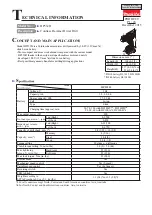
16
| English
1 609 92A 29W | (13.4.16)
Bosch Power Tools
An estimation of the level of exposure to vibration should also
take into account the times when the tool is switched off or
when it is running but not actually doing the job. This may sig-
nificantly reduce the exposure level over the total working
period.
Identify additional safety measures to protect the operator
from the effects of vibration such as: maintain the tool and the
accessories, keep the hands warm, organisation of work pat-
terns.
Assembly
Before any work on the machine itself, pull the mains
plug.
Auxiliary Handle
Operate your machine only with the auxiliary handle
14.
Changing the position of the auxiliary handle
(see figure A)
The auxiliary handle
14
can be set to any position for a secure
and low-fatigue working posture.
– Turn the bottom part of the auxiliary handle
14
in counter-
clockwise direction and swivel the auxiliary handle
14
to
the desired position. Then retighten the bottom part of the
auxiliary handle
14
by turning in clockwise direction.
Pay attention that the clamping band of the auxiliary han-
dle is positioned in the groove on the housing as intended
for.
Adjusting the Drilling Depth (see figure B)
The required drilling depth
X
can be set with the depth stop
13
.
– Press the button for the depth stop adjustment
12
and in-
sert the depth stop into the auxiliary handle
14
.
The knurled surface of the depth stop
13
must face down-
ward.
– Insert the SDS-plus drilling tool to the stop into the SDS-
plus tool holder
3
. Otherwise, the movability of the SDS-
plus drilling tool can lead to incorrect adjustment of the
drilling depth.
– Pull out the depth stop until the distance between the tip of
the drill bit and the tip of the depth stop corresponds with
the desired drilling depth
X
.
Selecting Drill Chucks and Tools
For hammer drilling and chiselling, SDS-plus tools are re-
quired that are inserted in the SDS-plus drill chuck.
For drilling without impact in wood, metal, ceramic and plas-
tic as well as for screwdriving, tools without SDS-plus are
used (e.g., drill bits with cylindrical shank). For these tools, a
keyless chuck or a key type drill chuck are required.
GBH 2-26 DFR: The SDS-plus quick change chuck
2
can easi-
ly be replaced against the quick change keyless chuck
1
pro-
vided.
Changing the Key Type Drill Chuck
(GBH 2-26 E/RE/DE/DRE)
To work with tools without SDS-plus (e.g., drills with cylindri-
cal shank), a suitable drill chuck must be mounted (key type
drill chuck or keyless chuck, accessories).
Mounting the Key Type Drill Chuck (see figure C)
– Screw the SDS-plus adapter shank
20
into a key type drill
chuck
19
. Secure the key type drill chuck
19
with the se-
curing screw
18
.
Please observe that the securing
screw has a left-hand thread.
Inserting the Key Type Drill Chuck (see figure C)
– Clean the shank end of the adapter shank and apply a light
coat of grease.
– Insert the key type drill chuck with the adapter shank into
the tool holder with a turning motion until it automatically
locks.
– Check the locking effect by pulling the key type drill chuck.
Removing the Key Type Drill Chuck
– Push the locking sleeve
5
toward the rear and pull out the
key type drill chuck
19
.
Removing/Inserting the Quick Change Chuck
(GBH 2-26 DFR)
Removing the Quick Change Chuck (see figure D)
– Pull the lock ring for the quick change chuck
6
toward the
rear, hold it in this position and pull off the SDS-plus quick
change chuck
2
or the quick change keyless chuck
1
to-
ward the front.
– After removing, protect the replacement chuck against
contamination.
Inserting the Quick Change Chuck (see figure E)
– Before inserting, clean the quick change chuck and apply a
light coat of grease to the shank end.
– Grasp the SDS-plus quick change chuck
2
or the quick
change keyless chuck
1
completely with your hand. Slide
the quick change chuck with a turning motion onto the drill
chuck mounting
21
until a distinct latching noise is heard.
– The quick change chuck is automatically locked. Check the
locking effect by pulling the quick change chuck.
Changing the Tool
The dust protection cap
4
largely prevents the entry of drilling
dust into the tool holder during operation. When inserting the
tool, take care that the dust protection cap
4
is not damaged.
A damaged dust protection cap should be changed im-
mediately. We recommend having this carried out by
an after-sales service.
Inserting SDS-plus Drilling Tools (see figure F)
The SDS-plus drill chuck allows for simple and convenient
changing of drilling tools without the use of additional tools.
– GBH 2-26 DFR: Insert the SDS-plus quick change chuck
2
.
– Clean and lightly grease the shank end of the tool.
– Insert the tool in a twisting manner into the tool holder until
it latches itself.
– Check the latching by pulling the tool.
OBJ_BUCH-279-007.book Page 16 Wednesday, April 13, 2016 11:14 AM
















































